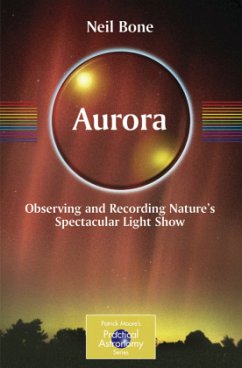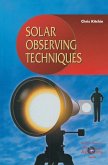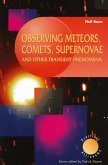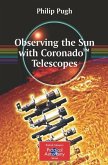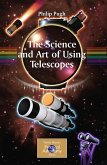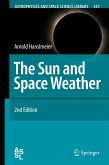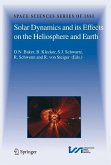For the majority of amateur astronomers, who live at the latitudes of North America, the British Isles and Australia, the aurora is a relatively infrequent visitor to the night sky. Major displays visible to the southern United States or the south of England occur perhaps 20 times in each 11-year sunspot cycle. When they occur, such auroral storms are a source of great interest and excitement.
A number of books highlighting the impact of auroral/geomagnetic storms on communications and satellite technology have appeared in recent years . None, however, has addressed the observational angle. This new book addresses a gap in the literature, offering an explanation of the aurora's causes, how the occurrence of major events may now be predicted, and how amateur observers can go about recording displays.
Observation of the more frequent displays seen at higher latitudes (the northern US, Canada, and Scotland, for example) are also covered in detail. Visual and photographic (chemical and digital) observations are most usual, but magnetic and radio recording of auroral effects is possible too.
While the principal aim of the book is to describe the aurora from the amateur observational viewpoint, it discusses professional studies of auroral/geomagnetic phenomena, to put amateur work in context.
A glossary gives concise explanations of necessary technical terms, and there is also a short bibliography.
A number of books highlighting the impact of auroral/geomagnetic storms on communications and satellite technology have appeared in recent years . None, however, has addressed the observational angle. This new book addresses a gap in the literature, offering an explanation of the aurora's causes, how the occurrence of major events may now be predicted, and how amateur observers can go about recording displays.
Observation of the more frequent displays seen at higher latitudes (the northern US, Canada, and Scotland, for example) are also covered in detail. Visual and photographic (chemical and digital) observations are most usual, but magnetic and radio recording of auroral effects is possible too.
While the principal aim of the book is to describe the aurora from the amateur observational viewpoint, it discusses professional studies of auroral/geomagnetic phenomena, to put amateur work in context.
A glossary gives concise explanations of necessary technical terms, and there is also a short bibliography.
From the reviews:
"It's a common misconception that the aurora can only be seen from very high latitudes. ... In all, this is a highly readable account that's profusely illustrated throughout and boasts a selective bibliography, a list of web sources and a glossary of technical terms. It's a must for everyone eager to watch for aurora when the next solar peak comes around." (David Gavine, BBC Sky at Night, November, 2007)
"The solar wind and its interaction with the Earth's magnetic field is a key to understanding how auroral activity arises. This is well illustrated by clear diagrams, tables and excellent photographs of the auroral oval. ... This book can be thoroughly recommended to anyone who observes the aurora or has ever been intrigued and curious about the northern lights." (Ken Kennedy, Astronomy Now, December, 2007)
"While it might seem odd to us who live in northern climes and often experience the aurora borealis on a nighty basis, some people travel thousand of miles with the hope of seeing these beautiful and colorful celestial lights. ... for those keen to discover the science behind the aurora, Bone's book is a must." (Paul Deans, Sky & Telescope, February, 2008)
"The aurora borealis and the aurora australis are striking if mystifying spectacles in the Northern and Southern Hemispheres, respectively. ... They are complex phenomena but their intricacies and causes are well described in this new book. Author Bone avoids mathematics but has filled his book with lovely color photographs of aurorae, north and south. ... Suitable for undergraduate and graduate students and an occasional high school student as well. Summing Up: Recommended. Upper-division undergraduates through professionals." (A. R. Upgren, CHOICE, Vol. 45 (5), January, 2008)
"This small book presents in greater depth a very readable account of the origins of the aurora with a concise explanation of the solar physics thatdrives sunspot activity and the related geomagnetic activity at the Earth. ... I recommend anyone who is curious about the origins of the aurora to dip into this monograph ... . In addition, amateur astronomers should enjoy the chapter about aurora on other planets ... ." (John I. B. Wilson, Contemporary Physics, Vol. 50 (4), July-August, 2009)
"It's a common misconception that the aurora can only be seen from very high latitudes. ... In all, this is a highly readable account that's profusely illustrated throughout and boasts a selective bibliography, a list of web sources and a glossary of technical terms. It's a must for everyone eager to watch for aurora when the next solar peak comes around." (David Gavine, BBC Sky at Night, November, 2007)
"The solar wind and its interaction with the Earth's magnetic field is a key to understanding how auroral activity arises. This is well illustrated by clear diagrams, tables and excellent photographs of the auroral oval. ... This book can be thoroughly recommended to anyone who observes the aurora or has ever been intrigued and curious about the northern lights." (Ken Kennedy, Astronomy Now, December, 2007)
"While it might seem odd to us who live in northern climes and often experience the aurora borealis on a nighty basis, some people travel thousand of miles with the hope of seeing these beautiful and colorful celestial lights. ... for those keen to discover the science behind the aurora, Bone's book is a must." (Paul Deans, Sky & Telescope, February, 2008)
"The aurora borealis and the aurora australis are striking if mystifying spectacles in the Northern and Southern Hemispheres, respectively. ... They are complex phenomena but their intricacies and causes are well described in this new book. Author Bone avoids mathematics but has filled his book with lovely color photographs of aurorae, north and south. ... Suitable for undergraduate and graduate students and an occasional high school student as well. Summing Up: Recommended. Upper-division undergraduates through professionals." (A. R. Upgren, CHOICE, Vol. 45 (5), January, 2008)
"This small book presents in greater depth a very readable account of the origins of the aurora with a concise explanation of the solar physics thatdrives sunspot activity and the related geomagnetic activity at the Earth. ... I recommend anyone who is curious about the origins of the aurora to dip into this monograph ... . In addition, amateur astronomers should enjoy the chapter about aurora on other planets ... ." (John I. B. Wilson, Contemporary Physics, Vol. 50 (4), July-August, 2009)

